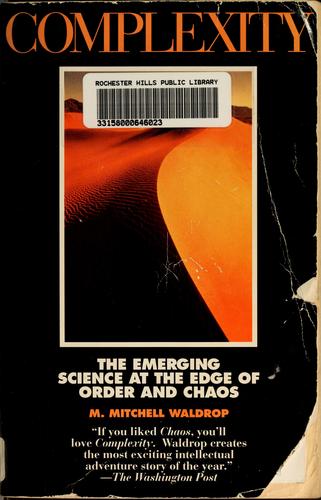380 páginas
Idioma English
Publicado el 1992 por Simon & Schuster.

380 páginas
Idioma English
Publicado el 1992 por Simon & Schuster.
"In a rented convent in Santa Fe, a revolution has been brewing. The activists are not anarchists, but rather Nobel Laureates in physics and economics such as Murray Gell-Mann and Kenneth Arrow, and pony-tailed graduate students, mathematicians, and computer scientists down from Los Alamos. They've formed an iconoclastic think tank called the Santa Fe Institute, and their radical idea is to create a new science called complexity." "These mavericks from academe share a deep impatience with the kind of linear, reductionist thinking that has dominated science since the time of Newton. Instead, they are gathering novel ideas about interconnectedness, coevolution, chaos, structure, and order - and they're forging them into an entirely new, unified way of thinking about nature, human social behavior, life, and the universe itself." "They want to know how a primordial soup of simple molecules managed to turn itself into the first living cell - and what …
"In a rented convent in Santa Fe, a revolution has been brewing. The activists are not anarchists, but rather Nobel Laureates in physics and economics such as Murray Gell-Mann and Kenneth Arrow, and pony-tailed graduate students, mathematicians, and computer scientists down from Los Alamos. They've formed an iconoclastic think tank called the Santa Fe Institute, and their radical idea is to create a new science called complexity." "These mavericks from academe share a deep impatience with the kind of linear, reductionist thinking that has dominated science since the time of Newton. Instead, they are gathering novel ideas about interconnectedness, coevolution, chaos, structure, and order - and they're forging them into an entirely new, unified way of thinking about nature, human social behavior, life, and the universe itself." "They want to know how a primordial soup of simple molecules managed to turn itself into the first living cell - and what the origin of life some four billion years ago can tell us about the process of technological innovation today. They want to know why ancient ecosystems often remained stable for millions of years, only to vanish in a geological instant - and what such events have to do with the sudden collapse of Soviet communism in the late 1980s. They want to know why the economy can behave in unpredictable ways that economists can't explain - and how the random process of Darwinian natural selection managed to produce such wonderfully intricate structures as the eye and the kidney. Above all, they want to know how the universe manages to bring forth complex structures such as galaxies, stars, planets, bacteria, plants, animals, and brains. There are common threads in all of these queries, and these Santa Fe scientists seek to understand them."
"Complexity is their story: the messy, funny, human story of how science really happens. Here is the tale of Brian Arthur, the Belfast-born economist who stubbornly pushed his theories of economic change in the face of hostile orthodoxy. Here, too, are the stories of Stuart Kauffman, the physician-turned-theorist whose most passionate desire has been to find the principles of evolutionary order and organization that Darwin never knew about; John Holland, the affable computer scientist who developed profoundly original theories of evolution and learning as he labored in obscurity for thirty years; Chris Langton, the one-time hippie whose close brush with death in a hang-glider accident inspired him to create the new field of artificial life; and Santa Fe Institute founder George Cowan, who worked a lifetime in the Los Alamos bomb laboratory, until - at age sixty-three - he set out to start a scientific revolution." "Most of all, however, Complexity is the story of how these scientists and their colleagues have tried to forge what they like to call "the sciences of the twenty-first century.""--Jacket.